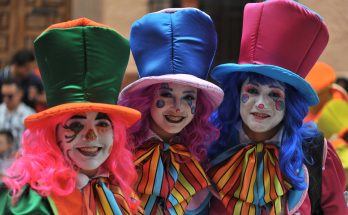By Talia Lara
“Over the last few months, we at Atención San Miguel, have striven to recover the historical memory of San Miguel de Allende. We strongly believe that for the community to build a better future, it is necessary to review the past. We have done this with the help of collaborators such as Arturo Morales, Natalie Taylor, and Luis Felipe Rodríguez (City Chronicler). Slowly, we are achieving our mission; we tell stories of famous people, we publish anecdotes and historical passages. But we also like to highlight and talk about the customs and traditions of San Miguel, all in order to not lose those memories, and to promote the essence of this beautiful community.
But a newspaper, by its nature, is ephemeral, and fleeting, because it can only tell short stories; therefore recovering memory in bits. Within this paradox we find the launch of a new book, San Miguel de Allende, its DNA, which tells about the people of San Miguel. Fortunately, such a book is here to stay; it overcomes the ephemeral, and sets a historical precedent for the entire community. For the first time, we have a complete retelling of the history of San Miguel, from prehistory to the second part of the 20th century. Once again history shows that we were always destined to be a crossroads. First it was a crossroads for animals of various species, then various indigenous groups that arrived from other latitudes, proven by the recent discoveries around Cañada de la Virgen. During the colonial period, everything was related to the Camino de Tierra Adentro—the Inland Road. Then, once we reach the 20th century, San Miguel residents crossed paths with foreign Mexicans and those from different countries: artists, businessmen, cultural promoters, academics, and a bunch of crazy people”.

–Francisco Peyret, General Coordinator of Atención San Miguel
On September 25, a new book about San Miguel was presented at the Instituto Allende. It was San Miguel de Allende, its DNA. It was written by Jesús Ibarra, based on an idea conceived by Jaime Fernández M. Harris. There were almost 400 people in attendance. Members of the panel presenting the book were Miguel de la Cruz, cultural commentator for Canal Once, Laura Bustos, director of the Ignacio Ramírez Cultural Center, architect Talía Lara, author Jesús Ibarra, and Jaime Fernández Harris.
The objective of the book, according to Fernández, is to show the new San Miguel generations what the San Miguel of other times was. “The purpose of this book is to transmit this memory, to prevent this identity from dissolving into oblivion; it is to try to create awareness in both young people, and people who have come from other places, about the profound historical and cultural importance of the city and its ancestral traditions,” Fernández concluded.
Jesús Ibarra said that the pages of San Miguel, its DNA, are full of stories and anecdotes of people from all times. Although it does not try to be a rigorous and academic history book, it has the bases of a deep investigation from both primary sources, and secondary sources. It also has oral testimonies from San Miguel residents who lived in the 20th century. In this way, it is intended to rescue that collective memory that forged the identity and essence of San Miguel, which deserves to last forever.
The book covers the entire history of San Miguel de Allende, beginning in prehistoric times. A chapter by Dr. Óscar Carranza, describes the animal species that lived in the San Miguel area, and that have been studied because of the fossils found here. Next, we talk about the pre-Hispanic cultures that developed in the area, through the studies carried out in Cañada de la Virgen. They speak of the nomadic Chichimecas that later inhabited the area, and other indigenous groups that arrived with the friars. Fray Juan de San Miguel who founded the first mission in what is San Miguel Viejo, and Fray Bernardo de Cossin who founded the Indian town of San Miguel de los Chichimecas.
Then there through the development of the Villa Protectora de San Miguel el Grande, different ethnic groups, castes that lived in the colonial period, as well as the main Spanish families are all described. There are biographical and family sketches of the insurgent leaders who participated in the War of Independence. Those born in San Miguel were Ignacio de Allende and the Aldama brothers, and the book speaks of the conspiracies that took place in the town and the outbreak of war. Based on ancient documents and chronicles, a follow-up is made of the events of these caudillos and their families, until their arrest and death in Chihuahua.
Following is a description of some of the main characters who lived in the San Miguel
From the 19th century: Ignacio Ramírez el Nigromante, and his family; Anastasio Bustamante; Lucas Balderas; Ángela Peralta, and others. Then there is information about the revolutionary events that took place in San Miguel; including some of the San Miguel residents who were involved in the Revolution. Those were: Federico Montes and Enrique Fernández Martínez—who was at then governor of Guanajuato, and was present when Álvaro Obregón was assassinated in La Bombilla. Fernandez Martinez was later the founder of the Allende Institute.
The guiding thread of the book is San Miguel de Allende and it continues with the founding of the University School of Art—predecessor of the current Ignacio Ramírez El Nigromante Cultural Center, Bellas Artes, founded by Stirling Dickinson and Felipe Cossío del Pomar. There is talk of the celebration of the Fourth Centenary of the Foundation of San Miguel, during which, peace was sealed between the Church and the State in Mexico. The differences between the two institutions were there since the War of Reform, and had been accentuated by the Cristero War. Both ecclesiastical and political authorities were present on that day, including Governor Enrique Fernández Martínez.
It is also about the founding of the Allende Institute, the history of both its founders, including Enrique Fernández Martínez and his wife Nell Harriss. There is information about the life in the town during the second part of the 20th century, as well as the importance of the Instituto Allende in the development of contemporary San Miguel. It talks about the traditions of our city, and its relationship with ancestral cultures. It concludes with a reflection on what San Miguel has been through time and where it is going in the present. San Miguel de Allende, its DNA can be purchased at the offices of the Instituto Allende, at Ancha de San Antonio 20.
Cover Photo Agustín Valadez




